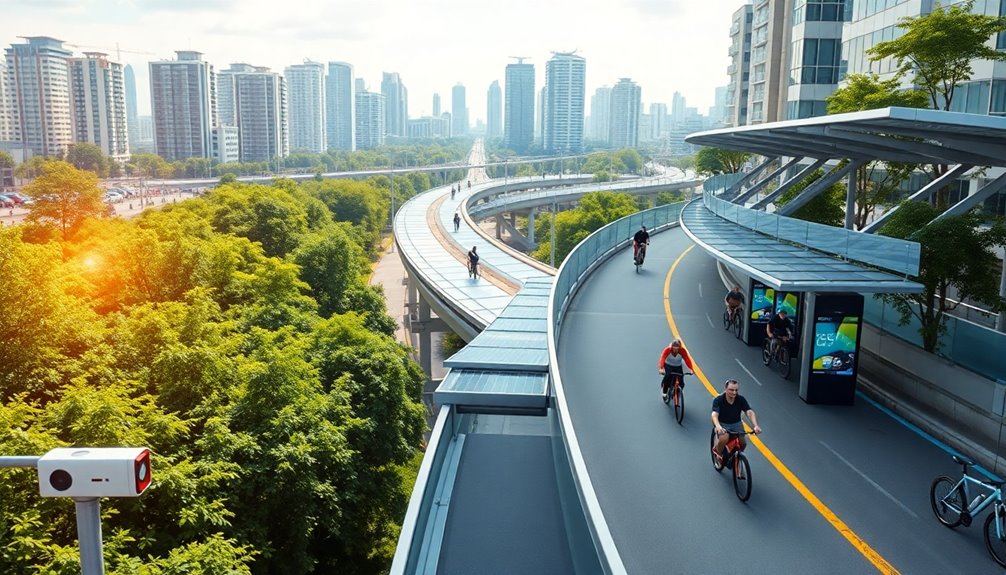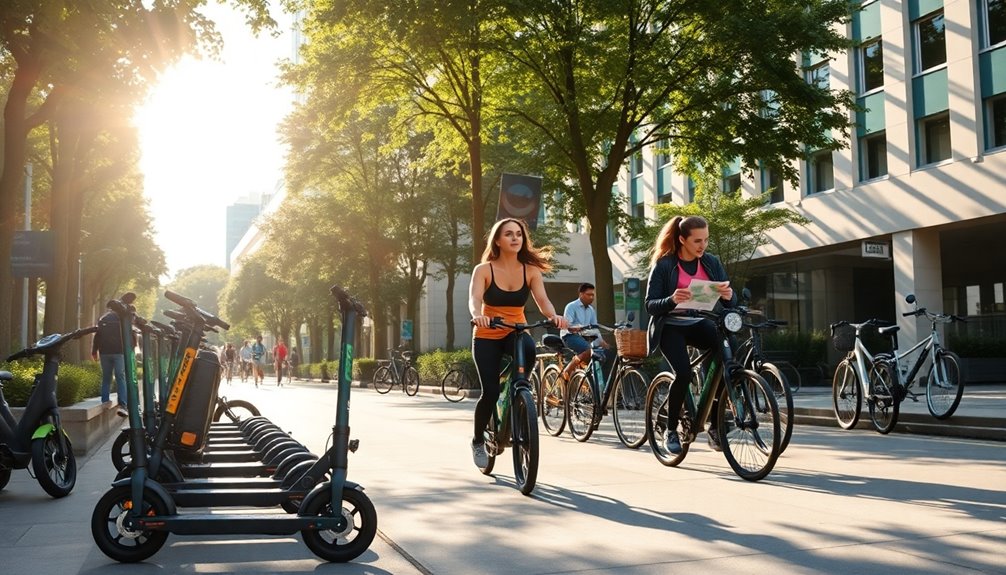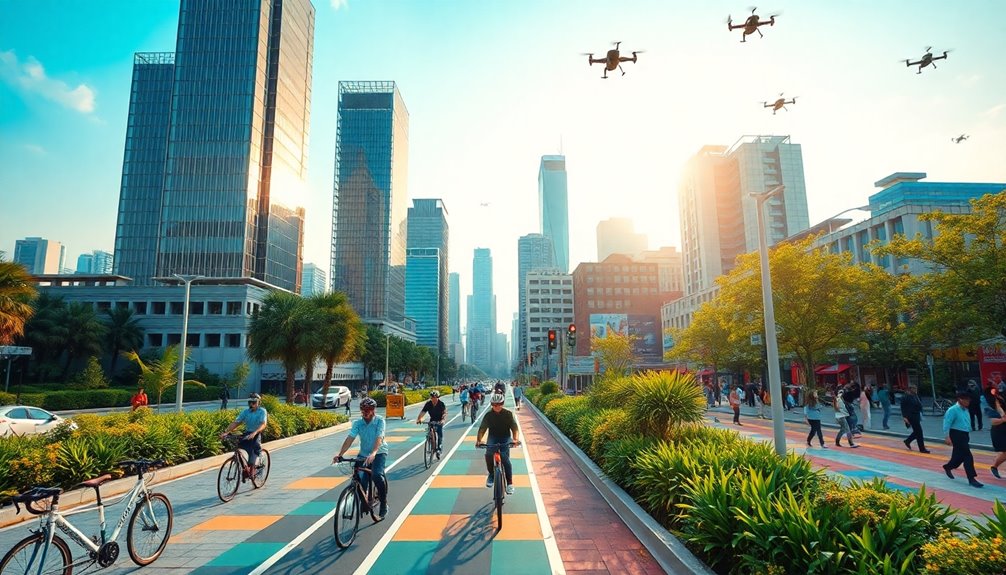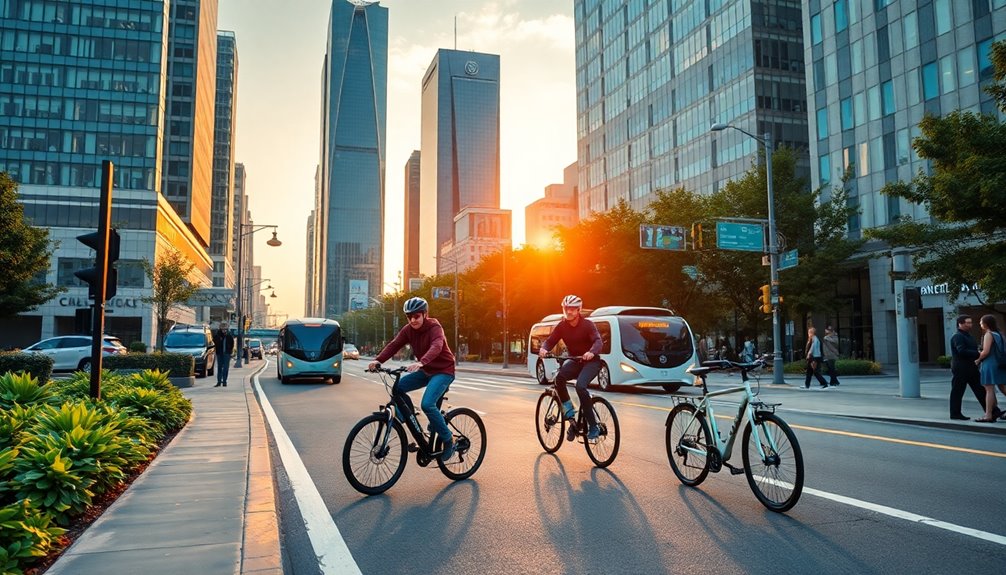Future innovations in urban mobility and cycling include advancements like digital twins for effective planning and safer cycling infrastructure, such as protected bike lanes. The micromobility market is booming, driven by e-bikes and scooters that ease congestion. Autonomous vehicles are reshaping public transport, enhancing accessibility and reducing costs. Sustainable urban planning focuses on green spaces and social inclusion. Keep exploring to discover how these trends will further transform our cities and your mobility experience.
Key Takeaways
- Digital twins will revolutionize urban mobility planning by allowing for scenario testing and risk reduction in infrastructure projects.
- Expansion of protected bike lanes and connected networks will significantly enhance cycling safety and accessibility in urban areas.
- The micromobility market, driven by e-bikes and scooters, is set to grow rapidly, promoting traffic alleviation and healthier lifestyles.
- Integration of autonomous vehicles into public transport will improve accessibility and efficiency, particularly in underserved regions.
- Sustainable urban planning will prioritize green spaces and cycling, addressing pollution and climate change while enhancing quality of life.
The Rise of Digital Twins in Urban Mobility

As urban areas continue to grow and evolve, the rise of digital twins in urban mobility is transforming how cities manage transportation systems.
The emergence of digital twins is revolutionizing urban mobility and enhancing transportation management in evolving cities.
These virtual replicas allow you to simulate and analyze various mobility scenarios before implementing changes. By integrating data on traffic, socio-economic factors, and the environment, digital twins create realistic models that help you evaluate potential impacts.
They empower planners to test "what-if" scenarios, leading to informed decision-making and reduced costs by minimizing risks associated with failed projects.
With applications in traffic management, public transportation, and parking optimization, digital twins enhance efficiency and sustainability, ultimately improving urban mobility for everyone.
As a result, you'll notice smarter, more responsive cities that cater to your needs.
Advancements in Cycling Infrastructure and Technologies

With cities increasingly prioritizing sustainable transportation, advancements in cycling infrastructure and technologies are reshaping how you navigate urban spaces.
Protected bike lanes are expanding in cities like Bogotá and Glasgow, making cycling safer and more accessible. You'll find connected networks in US cities, encouraging more people to bike and improving access to community resources.
Technologies like smart bikes and GPS tracking in bike-sharing systems enhance convenience for your rides. Electric cargo bikes are transforming urban deliveries, while cashless payment options streamline rentals.
As cities adopt Vision Zero initiatives, they're focused on eliminating traffic fatalities, ensuring that you can cycle with confidence and ease. This commitment to equitable access means cycling is becoming an integral part of urban life for everyone.
The Growth of Micromobility Solutions

Cities are increasingly embracing micromobility solutions as a natural extension of their cycling initiatives. This market, valued at USD 3.4 billion in 2022, is projected to grow to USD 6.1 billion by 2027, fueled by rapid urbanization and the demand for sustainable transport.
Micromobility options, like e-bikes and electric scooters, not only alleviate traffic congestion but also promote healthier lifestyles. Technological innovations, particularly in IoT, enhance user experience, with projections estimating the IoT solutions market in this sector will soar from USD 6.36 billion in 2025 to nearly USD 23 billion by 2033.
With government support and a focus on safety, micromobility is paving the way for a greener, more efficient urban future.
Integration of Autonomous Vehicles in Public Transport

While the rise of autonomous vehicles (AVs) promises to transform public transport, it also presents unique challenges and opportunities.
You'll benefit from enhanced mobility, especially in low-density areas where traditional services struggle. AVs can optimize routes and schedules, cutting operational costs while improving traffic management. They offer vital solutions for individuals unable to drive, fostering greater social inclusion.
However, adapting urban infrastructure and establishing harmonized regulatory frameworks are essential for successful integration.
You'll also see AVs play complementary roles with existing public transport, providing efficient first and last-mile solutions. Real-time monitoring and AI can further enhance operations and user experiences, ultimately revolutionizing urban mobility and making public transport more accessible and efficient.
Sustainable Urban Planning for Future Cities

The integration of autonomous vehicles in public transport sets the stage for a broader conversation about sustainable urban planning.
You'll find that this approach meets current needs while safeguarding the quality of life for future generations. By managing pollution and climate change, cities can foster healthier environments.
Prioritizing social inclusion ensures all residents access vital services, while supporting local businesses enhances economic sustainability.
Incorporating green spaces, like urban forests and vertical gardens, not only beautifies cities but also combats the urban heat island effect.
Additionally, cycling becomes a key component of urban mobility, promoting both environmental and economic benefits.
With a long-term vision, innovative designs, and collaborative governance, future cities can thrive in resilience and adaptability. Furthermore, diversification strategy in urban transport solutions can mitigate risks associated with over-reliance on a single mode of transportation.
Frequently Asked Questions
How Will Digital Twins Improve Urban Safety and Security?
Digital twins improve urban safety and security by providing real-time data that enhances monitoring and response capabilities.
You'll see quicker emergency response times, as these systems offer critical insights for efficient planning.
They help manage crowds effectively, reducing potential risks in busy areas.
Plus, with integrated surveillance, you can trust that your city's security is more coordinated, making your community more resilient and ensuring safety measures adapt to current conditions.
What Role Do Community Stakeholders Play in Mobility Hub Design?
Community stakeholders play a vital role in mobility hub design by ensuring that plans reflect local needs and values.
You'll see them helping prioritize features, allocate resources, and represent diverse community perspectives. Their feedback shapes the hub's amenities and layout, promoting equitable access for all.
How Can Cities Fund Electric Bike Initiatives Effectively?
To fund electric bike initiatives effectively, you should explore various sources like federal grants and state incentives.
Partnering with local organizations can help secure non-profit grants, while tax credits may offset costs.
Engage community members to identify specific needs and preferences, ensuring the funding aligns with their priorities.
Additionally, consider collaborating with businesses for sponsorship opportunities.
What Are the Environmental Impacts of Micromobility Solutions?
Micromobility solutions like e-bikes and e-scooters significantly reduce emissions, contributing to cleaner air in your city.
They're energy-efficient, often powered by renewable sources, lowering your carbon footprint compared to cars.
You'll also appreciate how they require less space for infrastructure, freeing up areas for parks and pedestrian zones.
Plus, with advancements in battery technology, these options are becoming even more sustainable, enhancing your daily commute while protecting the environment.
How Will Urban Mobility Trends Affect Rural Transportation Access?
Urban mobility trends often overlook rural transportation needs, leaving you with significant mobility gaps.
You might find that innovations like ride-sharing and electric scooters don't reach your area, limiting your options.
With an aging population and financial burdens, it's crucial to create tailored solutions that address your unique challenges.
Conclusion
As urban mobility evolves, think of cities transforming like butterflies emerging from their cocoons. Digital twins, advanced cycling infrastructure, and micromobility solutions are reshaping how you navigate your environment. Meanwhile, autonomous vehicles promise to enhance public transport, making it more efficient and accessible. By embracing sustainable urban planning, you're paving the way for healthier, greener spaces. Together, these innovations create a vibrant tapestry of movement, ensuring your future travels are as dynamic as the cities you call home.









